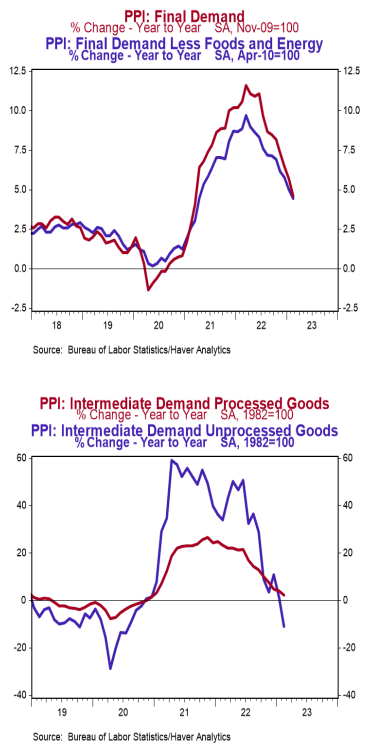- The Producer Price Index (PPI) declined 0.1% in February, coming in well below the consensus expected increase of 0.3%. Producer prices are up 4.6% versus a year ago.
- Energy prices declined 0.2% in February, while food prices fell 2.2%. Producer prices excluding food and energy were unchanged in February but are up 4.4% versus a year ago.
- In the past year, prices for goods are up 5.4%, while prices for services have risen 3.8%. Private capital equipment prices declined 0.5% in February but are up 5.5% in the past year.
- Prices for intermediate processed goods fell 0.4% in February but are up 2.1% versus a year ago. Prices for intermediate unprocessed goods declined 3.8% in February and are down 10.9% versus a year ago.
Implications:
Producer prices slipped 0.1% in February, further clouding the Fed’s decision-making process as it heads into next week’s meetings. Today’s data comes in contrast to yesterday’s CPI report which showed consumer prices up 0.4% in February and up 6.0% in the past year. Some will argue that the moderation in producer prices – though still well above the Fed’s 2.0% target on a twelve-month basis – paired with recent turmoil in the financial sector, demand a pause from the Federal Reserve. But the inflation fight is far from over, and while it certainly does look like peak inflation is behind us, the Fed’s failures in the 1970s show the painful ramifications of stopping before the battle is fully won. The Fed may take a pause on further hikes when they report next week, but we expect the path remains higher on rates as the economy continues to digest the massive increase in the money supply in 2020 and 2021. Taking a look at the details of today’s report shows that the goods sector led prices lower in February, declining 0.2%. Drops in food prices were the key culprit, with prices for chicken eggs falling a massive 36.1% in February. Energy prices declined 0.2% in February as a drop in costs for natural gas and diesel fuel more than offset rising prices for gasoline. Removing these typically volatile food and energy categories shows “core” producer prices were unchanged in February and are up 4.4% in the past year. Further back in the pipeline, the story is the same, with lower costs in February for both intermediate demand processed (-0.4%) and unprocessed (-3.8%) goods. Signs of easing prices are a positive, but we aren’t to the finish line yet. In other news this morning, the Empire State Index, a measure of New York factory sentiment, plummeted to -24.6 in March from -5.8 in February, marking a fourth consecutive month of contraction.





